Garden trends 2023 revealed: 19 key trends you'll be seeing in backyards everywhere next year
Garden trends for 2023 are making the most of your outdoor space, turning it into a place to enjoy all year
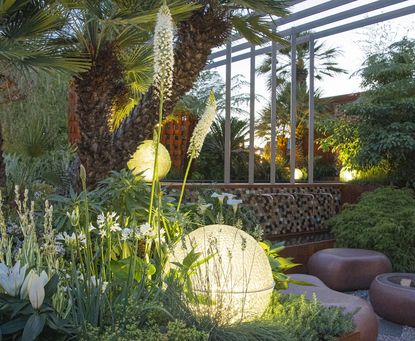
Garden trends are now officially a thing like never before. The shift to utilising our outdoor spaces has accelerated lately as we're spending more time at home both for work and leisure. This means we all want to know what's trending when it comes to style inspiration for outdoor living.
As within many interior design trends, there are new ideas for segueing together that all-important indoor-outdoor feel, which remains as popular as ever, plus we’ve covered the latest color trends. Next year also promises to be big on growing your own flowers for cutting, and making a sanctuary where you can connect with nature. Meanwhile gardening sustainably has never been more important.
What's certain is it's going to be an exciting year for being outside, with nods to Mediterranean and Central American vacations a key aesthetic for backyards. ‘The rise of earthly neutrals has been growing recently,' says Paula Taylor, head stylist at Graham and Green. 'They are warm and welcoming, and their connection with nature creates a warm and relaxed atmosphere.’
What are the garden trends for 2023?
1. Easy cutting garden flowers
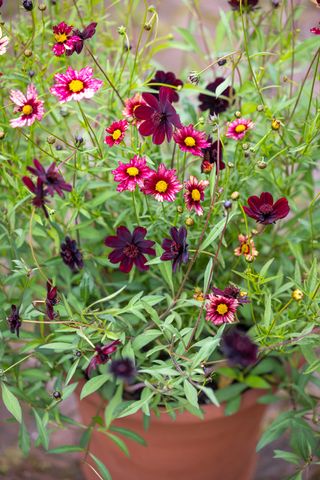
The Velvet Cut Flower Container Collection from sarahraven.com features Cosmos atrosanguineus ‘Chocamocha’ and Coreopsis ‘Red Shift’
Even the smallest urban terrace garden can be transformed into a cutting garden if you grow the right cut and come again flowers. All garden plants are fair game for the vase. ‘Contemporary styles of floristry are going to be blended with a cottage garden look in 2023,’ according to cutting garden experts Camila Romain and Marianne Mogendorff, founders of the Wolves Lane Flower Company. ‘We're preparing ourselves to cut armfuls of garden stalwarts like ammi majus, corncockle and sweet peas for that wispy romantic style. There’s a trend for being bolder with color too, meaning that we'll be growing more rudbeckia and cutting punchier foliage like physocarpus and ornamental cherry.’
There’s also a trend for growing your own. ‘We're seeing more and more people wanting to grow their own flowers from seed, even on a small plot or balcony,’ say Camila and Marianne. They suggest trying cosmos, a beautiful half-hardy annual, loved by pollinators and florists alike
Plant expert Sarah Raven agrees: ‘Even if you only have a tiny garden – or just some pots – you have to grow at least one cosmos. They are the lowest maintenance, floweriest plants in the world. For me, cosmos is the classic cut flower and a supremely lovely garden plant. In reward for very little effort, they give you buckets of cut flowers, and they have a very good vase life too.’
2. Sun-baked terracotta tones
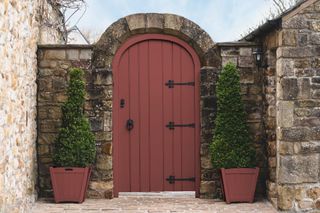
At Cultivate’22, Katie Dubow, president of Garden Media Group, delivered the 2023 Garden Trends Report and announced that terracotta is the color of the year. ‘Revived from the acid oranges of the 60s and 70s, terracotta signifies an optimistic future,’ she said. ‘It evokes a spirit of so many different cultures, and all the different ways the different cultures think of this color. It’s about warmth, excitement and amusement, and that’s what 2023 is going to be all about.’
Be The First To Know
The Livingetc newsletter is your shortcut to the now and the next in home design. Subscribe today to receive a stunning free 200-page book of the best homes from around the world.
Paprika, the punchier cousin of terracotta, is already a key color trend for interiors confirming that the emphasis is very much on sun-baked shades for 2023. Alysha Alli heads up the design team at homebuilders Redrow. She agrees that terracotta shades are set to be big. ‘Dusty, sandy neutral tones create a feel-good, summery palette, while natural pigments inspire harmonious earth tones. The color terracotta instils a sense of relaxation and craft in the home and garden. We’re expecting to see this palette boom as it combines saturated shades with soft and grounded hues to echo the shift towards beautiful tones that fill us with joy.’
3. Mykonos vibes

Greek-inspired gardens are having a moment, according to Katie Dubow, and we are all-set to embrace this trend. Greek gardens are about highlighting romantic beauty, which includes statues, stone garden walls and archways.
‘Including a statue adds another dimension to a space,’ agrees Henry Bartlam, founder of Dig. ‘Nestling the statue within planting means that it is softened by the greenery and creates an impression of being just discovered. Ideas such as pops of color in a predominantly whitewashed garden also evoke Greece. Using natural materials such as stone walls rendered white can also be effective and visually interesting. To maintain a calm space, limit the number of colors and plants used.’
Dubow also suggests using plants to shade seating areas, and using hardy and water-wise plants like succulents and boxwood, as well as bulbs like agapanthus.
In terms of overall aesthetics, expect to see gardens inspired by holiday destinations as the go-to choice. ‘Clients are looking to create their favorite holiday destinations at home, like playing with the blue and white tones inspired by Mykonos,’ says Reilly Gray of Suns Lifestyle. ‘The year 2023 will be all about stepping into the garden and instantly being transported to a holiday destination.’
4. Lit garden sculpture
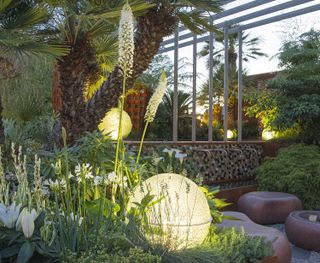
Garden designer Kate Gould uses large hand-shaped glass spheres by Catellani and Smith as sculpture highlights in the day that come into their own at night when they light up the garden
A well-chosen piece of backyard art will help you connect to and engage with the yard and its wider setting, adding to a sense of place. This is a trend that’s shaping up to be big in 2023. ‘We have noticed growing interest from clients who want to include works of art in their outdoor space,’ says designer James Scott of The Garden Company.
The benefits of installing a beautiful sculpture are many. ‘Often its purpose is to provide a focal point, drawing and directing the eye so that the whole yard is gradually absorbed rather than taken in too quickly,’ says James. The sculpture may be used to frame a view further out in the backyard or beyond, or as an end destination in itself.
A well-placed sculpture or sundial acts as so much more than a piece of art. ‘It’s a conversation starter, a thought provoker and a sense of calm and stillness in an otherwise fast-paced world,’ says David Harber, who is known for his outdoor installations. David’s latest collaboration with architectural lighting specialists John Cullen seeks to elevate sculpture in the yard with good lighting to create atmosphere and mood at night-time too.
5. The sanctuary garden
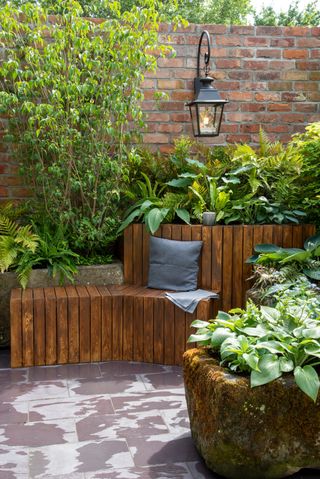
Enchanted Rain Garden design by landscape architect Bee Tain
The popularity of mindfulness and wellbeing spaces has grown over the past couple of years, as we have discovered what a sanctuary our backyards can be. ‘Having any outside space, large or small, where we can immerse ourselves in nature is so good for our state of mind,’ says garden designer Fiona Lamb.
This year the Chelsea Flower Show even had a separate category of sanctuary gardens, where we saw everything from yoga platforms to outdoor spas and everything in between. ‘All were restful and restorative spaces, giving us cause to pause, to reflect and just to be in a calming place,’ says Fiona.
In our own outdoor spaces we can create such feelings by introducing water, using a soothing color palette and by creating small, enclosed areas that allow us to take a moment, to immerse ourselves and reconnect with nature. ‘Planting in a wellbeing garden should focus on texture and form, not color,’ says garden designer Penelope Walker. ‘Planting is primarily green with architectural and/or tactile foliage. Green is a very relaxing color and should be the main color when trying to create a calming effect.’
6. Decorative screens
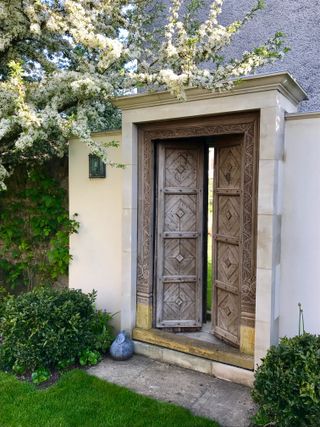
If you have a small backyard it needs just as much thought as a large one, if not more. The limited space focuses your mind as you need to make sure every inch is utilized. Keeping the focus within the space is key while making it feel as spacious as possible.
This is where the trend for decorative screens comes in. They are good for adding privacy in overlooked city spaces and dividing up a space into zones. The current fashion is for metal panels intricately patterned with a botanical, laser-cut designs that look good as a contrast to naturalistic planting.
You can also use decorative screens to play tricks. ‘Adding a portico with doors and a mirror to the space can give the illusion that there is more beyond,’ says garden designer Fi Boyle. ‘This screen gives the illusion that there is another backyard beyond the doors while giving a focus, distracting the eye from anything beyond.’
7. Architectural lines paired with naturalistic planting
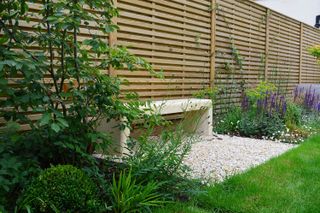
Another key trend for 2023 is that garden designers are increasingly looking to develop urban spaces where strong architectural lines are softened with naturalistic planting. ‘Historically, hard landscaping, evergreens and shrubs have provided a backbone for more fluid plantings of perennials and annuals,’ says garden designer Eliza Gray. ‘But the modern urban backyard embraces a more organic flow of drifts of plants, self-seeded surprises with ground cover planting to minimise maintenance.’
The structure of this backyard is defined by use of well-considered hard landscaping materials, installed with close attention to details such as corner joints and transitions between surfaces. The outline of the linear bench is softened by tall airy planting such as ornamental grasses and pretty low edging plants like Mexican fleabane.
‘Hotter summers mean a move away from the traditional lawn, instead embracing dry gardens, ground cover planting and larger planting beds,’ says garden designer Eliza Gray.
8. Patterned tiles

Patterned tiles in exterior spaces are trending. Whether you go big or small, symmetrical designs help to personalize patios and other outdoor spaces. This small urban garden is surrounded by brick walls. ‘The client asked me to design a garden inspired by Chanel,’ explains the designer Roberto Silva. ‘The first idea that came into my mind was using a black and white tile design. Tiles are going to be a big trend in 2023 as more and more designers are now using them.’
Small urban spaces can be challenging. Using distinctive tiles adds a strong design element, especially when combined with bold shapes such as this circular design. The white column with fire pit installation was built to add architectural interest, while planting is colorful and feminine, with acer japonica, agapanthus and viburnum davidii combining to create a distinctive look.
9. Drought-friendly gardens
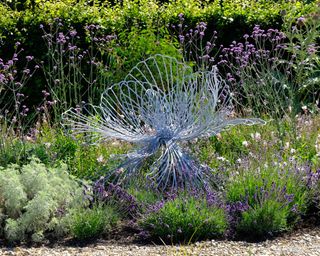
Options for drought-resistant plants and sustainable hardscaping are becoming more and more sought after as our choices gradually evolve to accommodate the effects of climate change. It’s an easy look to get right too as many drought-resistant plants naturally thrive in the same conditions. ‘Usually plants that have grey-green leaves to reflect the heat such as sage, rosemary and santolina are drought tolerant,’ says Dig’s Henry Bartlam. He suggests artemisia and hebe as good hard-working shrubs, and when it comes to perennials trying euphorbia, echinops, heuchera and verbena.
There is also a trend for palm trees such as Trachycarpus, and the airy ornamental grasses pennisetum, panicum and stipa, which will also suit these planting conditions.
Collecting rainwater and using water butts is a great way to conserve water, while gravel gardens as a style of planting is low maintenance and lends itself to drought tolerant planting.
10. Boutique-hotel style furniture
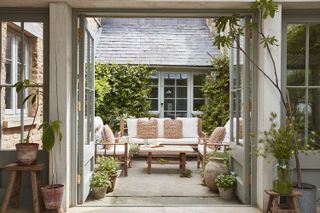
The outdoor living room is another key trend that will continue to dominate in 2023, according to Sun Lifestyle’s Reilly Gray. Key to getting this look right is choosing furniture that looks like more of a fit with your interior design rather than an add-on to the garden.
‘Outdoor furniture design has evolved and we’re seeing high-end design being combined with state of the art materials to create furniture pieces and upholstery that look beautiful,’ says Reilly. ‘Modular corner units will be the go-to choice, allowing flexibility when it comes to layout, while outdoor textiles such as rugs, cushions and throws will help to create that boutique island hotel feel. It’s all about creating an aspirational, social media-worthy lounging space.’
Neutral colour palettes will be popular next year too. ‘These shades are calming, natural and everlasting and blend very well into the natural environment,’ says Maze MD Andy Baxter. ‘Neutral colors, such as a white, can be offset beautifully against lush greenery.’
11. Sustainability
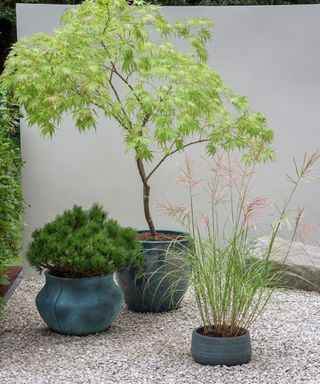
A peaceful spot is everything in a city garden (A Tranquil Space in the City designed by Mika Misawa)
What else is on the radar? Sustainable living has never been more important, with biodiversity, naturalistic planting and bio-based materials that put the planet first at the heart of this trend.
“Sustainability has never been more important than now," says acclaimed garden designer Charlotte Rowe. "We recognise the need for irrigation in the first year or so in a new garden design to help the plants get established but after that plants should be able to stand on their own two feet, except for a bit of extra water in drought conditions. It’s that old adage that works every time – choose the right plant in the right place.”
Creating somewhere to enjoy moments of stillness in the garden is also important to boost mindfulness and mental wellbeing. Our gardens are a pocket of peace and quiet, a place where we can find refuge in a ‘wellness bubble’ and escape our hectic days. It’s the ultimate form of stress relief and we all want one right now.
For another sustainable planting idea, try your hand at chaos gardening, a carefree approach to landscaping that encourages use of any remaining seeds you have lying around.
12. Pastels mixed with fire tones
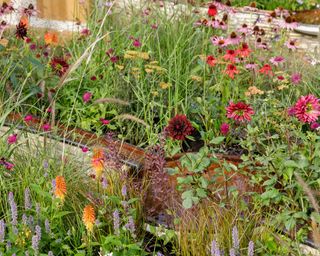
The new autumnal color palette is on fire (Finding our way: An NHS Tribute Garden designed by Naomi Ferrett-Cohen)
Talking of moods, fresh color accents can help to bring energy to your outdoor space too. Similar to what we've seen in color trends generally for 2023, pastel tones such as pink, blue, mint green and pale orange alternate with more vivid accents.
A beautiful sunset provides the inspiration for the colors to use, playing with the orange, red and yellow palette felt new and fresh. Alongside pastels, 2023 is all about hot and fiery colours.
So whether you want to freshen up the look, introduce some retro blooms or go for a complete overhaul here are the key garden design trends you need to know about.
13. Gravel and wood chip paths
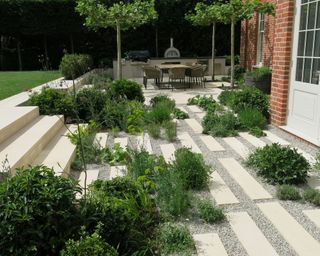
Mixing gravel into the hard landscaping softens the look and is a good choice for planting pockets too
“Solid paths and paving is giving way to gravel, wood chip and other natural materials," says Charlotte Rowe on the latest landscaping trends. "I’m hoping that more gravel might be used as sustainability is such a key trend now. We designers love gravel for its permeability and flexibility. It’s also really good for drainage and great for planting in, as well as being an affordable choice.
“People are beginning to understand that drainage is key to good sustainability, in particular in our cities where flooding is becoming increasingly common. Paving over front gardens is not a good idea and we always encourage good drainage, permeable ground surface and as much planting as possible in front gardens.”
14. Textured stone
“We use a combination of brushed or slightly textured limestones and sandstones and smooth or honed stones to give additional interest," says Charlotte Rowe, talking of her latest garden border ideas. "Clearly you can’t use polished stone outside in gardens as they become too slippery but honed is fine though some designers only used textured paving.
“We recommend the use of stone with traceable provenance. We prefer to know where the stone we use has come from.”
15. Organic gardening

A sublime mix of planting and the egg chair of our dreams (The Yeo Valley Organic Garden designed by Tom Massey)
“People are becoming more aware of ‘organic' in gardening terms and I think organic gardening and growing are now much more popular and mainstream,” says Your Garden Made Perfect expert and leading designer Tom Massey. His Chelsea design for Yeo Valley Organic won a Gold medal and the BBC People’s Choice award, and he highlights this idea that goes hand in hand with no dig gardening, which has been gaining popularity too - the idea of not interfering too much.
Tom’s Chelsea garden featured an open perennial meadow brimmed with flowering plants full of colour and texture. Silver birch, medlar trees and native hedging give the garden a leafy, natural framework. Sweeping log walls divided the space, formed of carbon-rich biochar logs, charcoal being a great soil improver, and highlighting the importance of keeping carbon in the soil. An egg-shaped oak hide provided a place to relax, unwind and observe the natural environment and visiting wildlife.
“Organic principles are a set of guidelines that people can follow to garden organically,” Tom explains. “They include nurturing soil health, encouraging biodiversity, using resources such as water responsibly and avoiding the use of chemicals. Even if you only adopt a few of these principles, it can make a big change to the heath and sustainability of your garden.”
16. Successional planting
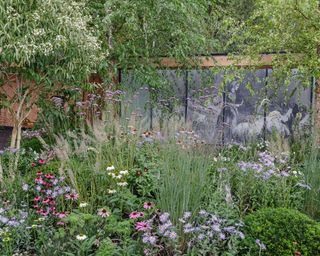
The Florence Nightingale Garden designed by Robert Myers Chelsea Flower Show
Backyards can still look beautiful and interesting outside of the main spring/summer flowering season. Successional planting, which we can all do on some level in our own gardens, is one of the new garden trends that's here to stay. It means that there will always be something interesting to look at, to show off as part of your front garden ideas, and is never more important than now with the new emphasis on outdoor living.
“The key to successional planting, particularly in smaller urban gardens which are often on immediate show all year round, is a good evergreen structure,” says garden designer Fiona Lamb, who is known for her stylish bespoke outdoor spaces. “These plants will form the backbone of your garden and enable you to intersperse with ‘pretties’ that will add colour, movement and interest throughout the year.”
So what are the best plants to use for successional planting? “Spring bulbs – camassia, tulips, narcissus, alliums and early flowering plants like hellebores get the year off to a great growing start. These make way for summer perennials to shine. They hand over to late bloomers like anemones, rudbeckia and hylotephium. Grasses, seedheads, coloured bark and brave winter flourishers then carry us through until the cycle starts again.”
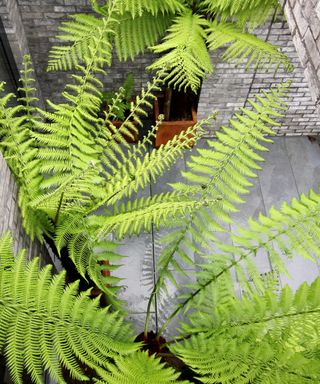
Urban courtyard garden design with Dicksonia tree ferns by Fiona Lamb Design
17. Connection to the natural world
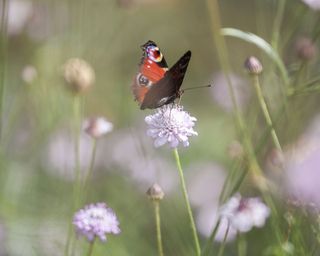
Gardening lets you be part of the natural world and this connection is cemented by the planting you choose. The current trend is very much for loose and naturalistic swathes, and rewilding projects are big news.
Award winning landscape designer and horticulturalist Dan Pearson is known for his painterly naturalistic planting, and has worked with everyone from Juergen Teller and Paul Smith to the National Trust and the Garden Design Museum. His recently launched online course with Create Academy focuses on naturalistic garden design trends.
“Never more so than now has it been this important that we think about our connection to the natural world and not set ourselves apart from it,” says Dan. “Gardens and gardening allow us a way in to this connection and it’s no surprise that a more naturalistic approach to making and tending our garden spaces is now so embraced and embedded.
"A naturalistic garden provides sanctuary for not just us, but a richness of biodiversity where a lighter hand on control is applied. A naturalistic garden is not just an aesthetic, it's an approach and a way of life.”
18. Making your space work harder

Attention to detail is everything as this mix of planting and hard landscaping shows. It keeps the garden visually interesting all year round (The M&G Garden designed by Harris Bugg Studio)
The work of design duo of the moment and Chelsea gold medallists Harris Bugg encapsulates the design trend for gardens that have spirit of place and are in keeping with their surroundings. One recent commission was a modern parterre design in Chiswick for Cara Delevingne, and they have also worked with the new RHS Bridgewater garden and the National Trust.
“The past eighteen months have seen a huge trend towards us all enjoying and valuing our gardens, and spending more time in them right through the year,” says one half of the duo, Hugo Bugg. “Making spaces work harder for longer seasonal use, from fire-pits to outdoor furniture, is the current trend and that goes hand in hand with the planting and how we keep visual interest going through the seasons.”
Planting palettes should ensure there is always something new to explore and enjoy, whatever the season. Over to Charlotte Harris: “By selecting trees and plants that keep on giving, whether spring blossom, summer flowers, a crescendo of autumnal leaves and berries, or the beauty of frost on seed-heads, both improves our experience of our gardens but also helps wildlife, often providing important food and shelter sources when they need them most.”
So what should we be planting to tap into these garden design trends? “Trees such as crab apples, hawthorns and Amelanchiers are perfect for even the smallest of gardens, and offer much in terms of longevity. On a smaller scale, grasses like Miscanthus hold their structure long into winter. Amsonia enjoys a mass of small star-shaped blue flowers in early summer before the plant slowly turns a rich ochre in September with stunning bronze seed heads.”
19. Vertical pocket gardens
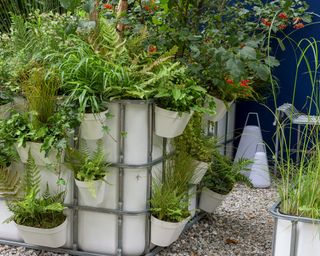
'Pocket forest gardening' is the latest green wall trend that demonstrates how you can create a micro eco system in even the smallest of spaces (The IBC Pocket Forest designed by Sara Edwards)
Don’t just think of the floor. Look up and try a living wall to green up a small space. “Living walls or green walls are simply vertical gardens, where plants are rooted into a structure that is attached to a wall, creating lush panels of green,” says Isabelle Palmer, founder of thebalconygardener.com, which specialises in products for small urban outdoor spaces.
“Living wall systems are sold as kits, and can be scaled up or down to suit your space and budget. They're incredibly easy to construct and you can get them up and running in a weekend. They are an excellent screen idea for more privacy if you live in an apartment block.”
Why not tap into these garden design trends and make a great focal point on a balcony or terrace with a green wall as centre stage. “It will also naturally purify the air in your space as well as attracting wildlife, so it’s ideal for city living,” adds Isabelle.
Amazon sells a great selection of pocket garden holders here.
Go large with pots and planters on roof gardens, terraces and balconies. "Using statement pots gives you a real focal point and that sense of lush greenery en masse," says Isabelle. 'Make sure you keep to a simple design and use materials and colours that complement each other so your plants stand out. Gardening is beneficial, however small the space. So give these garden design trends a try.”
Lifestyle journalist Sarah Wilson has been writing about flowers, plants, and garden design and trends since 2015. Having already studied introductory garden and landscape design as well as a course in floristry she is currently adding to her list of qualifications with an RHS Level 2 course in the Principles of Plant Growth and Development. In addition to livingetc.com, she's also written for homesandgardens.com, gardeningetc.com, Modern Gardens and Country Homes & Interiors magazines.
-
 This Viral Gardening Trick Can Make Your Lawn so Much Healthier Using a $5 Beauty Product
This Viral Gardening Trick Can Make Your Lawn so Much Healthier Using a $5 Beauty ProductGardening experts let us in on this extremely affordable and incredibly efficient hack for a lush lawn
By Amiya Baratan Published
-
 4 Types of Items to Avoid Storing in a Small Kitchen to Maximize Space and Reduce Clutter, Say Professional Declutterers
4 Types of Items to Avoid Storing in a Small Kitchen to Maximize Space and Reduce Clutter, Say Professional DeclutterersOrganizing experts tell us what items you should be stowing away for a tidier kitchen space
By Amiya Baratan Published